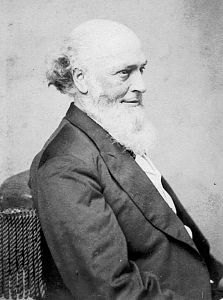

This is the only known photograph of Thomas Johnston. (Photo courtesy of Bud Phillips)
*** Published: March 1, 2009 in the Bristol (Va.) Herald Courier. ***
I once worked in a large antique shop that imported and sold a lot of fine portraits from England. We had a private joke in the shop of how some of our customers were buying "instant ancestors." It was true that some who bought our portraits did hang them in their homes and claimed that he or she was an affluent ancestor.
Whatever the case, then or now, hand-painted portraits are often regarded as status symbols. It is mainly for that reason that they are usually rather expensive.
Before the era of photography, the only real way to preserve the image of any person was to commission an artist. The cost was prohibitive for most families, even though the work often cost less than $20 through most of the early and mid-1800s.
Costs varied as to degree of detail, background choices and size of image (full length, 3/4 or bust). Often, only one member of the family was chosen to have such an image made. This is why good, old portraits are now rather rare.
Artists skilled in portraiture were few, thus they enjoyed considerable status in society of the time. Some of them traveled from place to place, usually lodging in the homes where they worked. Others maintained art studios. The latter usually operated in cities or larger towns.
It is not generally known that early Bristol had her own portrait painter. His name was Thomas C. Johnston. He was born in Campbell County, Va., in 1819. He had moved to the new town of Bristol by September of 1855.
His father, Hugh Johnston, moved here at the same time and established his home on Water Street in what is now Bristol, Va. The street no longer exists and was located in the general vicinity of the present Bristol, Va. courthouse.
Thomas, who must have had considerable wealth when he moved here, soon built what was long the finest house in downtown Bristol, Va. This house stood on the northeast corner of Main (now State) and Moore. It was of solid brick construction and was built by William Rodefer and James Fields, master builders of Abingdon, Va.
It was the four-square design with full English basement, essentially making a commodious house of eight large rooms. Each of them had a large fireplace. There was a Greek Revival-style portico on the front facing the street. In back was a detached kitchen and slave quarters.
Thomas had a basement art studio but also traveled to various localities in this area to work. Jonesborough, Tenn., seems to be one of his favorite fields of labor. Provided he had known a person, Thomas Johnston could paint a good portrait from memory after that person was gone. He was much sought after for that purpose.
He and his family occupied the downtown house until 1862 when it was sold to Rev. James King. A move was then made to his father's home on Water Street. His father, Hugh, died March 19, 1874. His mother died a few years later.
Thomas continued to live there, taking care of his three maiden sisters until his death in late 1892. This early portrait painter, his wife and one or more of his children, are buried in the L.F. Johnson lot, Section 1 B in Bristol's historic East Hill Cemetery.
Seldom ever were his works dated or signed, thus they are hard to identify. There is recollection that, to supplement his portrait painting, he served as an ambrotypist here also (a form of early photography). I have the names of his several brothers and sisters, and will share them with anyone who may be interested.
And what of the grand house that he built in downtown Bristol? The Kings occupied it for a few years. During their time there, the large lawn at the front was turned into a virtual rose garden. For that reason, the place became known as Roselawn.
After the death of the Kings, the house became the property of their granddaughter, Charlotte (Chassie) King, who soon married Dr. A.M. Carter. Then, in 1887, Dr. Carter had the house and outbuildings demolished and erected a large business house on the site. Bricks from the older building were used in the construction of the foundation of the new building. Descendents of Chassie King Carter still own this building. It is now home to Rylands Jewelry Store and Boxwood Antiques.
BUD PHILLIPS is a local historian and author. He can be reached at (276) 466-6435.